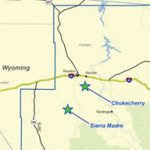In this installment we’ll look at ways to identify broken tiles and methods to repair them quickly and efficiently. From last month’s column—available at www.windsystemsmag.com—it should be assumed that if you are working in tiled farm country, you should anticipate damaging tiles.
The first thing is to effectively spot and ascertain damaged tiles. While there are innumerable ways to damage a tile, there are luckily only a few ways to spot and notice damaged tiles from the surface. The first and easiest is to look for and identify small sinkholes in the field, typically ranging anywhere from 2 inches in diameter to over 4 feet, and that are as deep as the tile. These sinkholes are caused when a single section of clay tile becomes crushed while the tile is still flowing with enough water to create a suction action that essentially liquefies the earth above it and then sends it downstream in the undamaged pipe. While crop damage is usually minimal with this type of break, it presents the greatest risk to farm machinery, especially if it is discovered by accidentally driving into it.
The second and far more common type of damage is a crushed tile made of clay or plastic that either stops flowing altogether or is crushed to the point where the flow is diminished significantly. Once the tile is crushed water will slowly start backing up and will eventually appear on the surface, either as very obvious standing water or more subtly, as otherwise healthy crops start to show signs of excess moisture. These are the types of tile damage that are hard to determine in the field, since the damage may take years to manifest itself. It is not uncommon for a partially crushed tile to finally build up enough sediment that it stops working altogether three to five years after the initial damage. Also, the damage will not show itself in particularly dry years, or during years with well-spaced rain showers. The tiles were designed to quickly remove the excess ground water after major rains or flood events. So, without these rains a broken tile may show no signs of apparent damage.
Typically the landowners or farmer tenants will approach you with concerns about damaged tiles. Their extensive knowledge of their property helps them identify subtle year-to-year nuances that would otherwise go unnoticed by construction personnel. If they indicate that there is a broken tile in the area, it is usually best to assume that they are correct. Ideally, it is advisable to line up a local tiling contractor to come in and make the repairs as needed. However, if you plan on repairing the tiles yourself, prepare for a little trial and error to find the physically damaged spot. Many times the wettest location is not where the tile is actually broken, but where it has built up enough “head” to become apparent on the surface.
Unless it is obvious where the tile is damaged, start by digging a trench perpendicular to the suspected direction of the tile. Once you find the tile, it is easy to discover where you are in regards to the damaged section. If water is boiling up at you from the tile, you are upstream of the break; if it is dry, then you are downstream. Keep narrowing in on the damage until you find the crushed section. Also, keep in mind that if you suspect that it was crushed by tracked equipment instead of cut by a collector line, it is an excellent idea to look 20 feet up- and downstream for where the other wheel track crossed the tile.
Once you find the break, it is a relatively simple process to remove the damaged section and splice in a new piece. However, based on the level of water the tile was holding back, you may have to allow it to drain for several days or pump the water out of the hole to make an effective repair. Another suggestion is to have a small dry-erase board and camera with each tiling crew. Instruct your crews to note the tile type, size, location (GPS coordinates), date fixed, and the approximate heading of the tile. If you have the capabilities, plot these locations on a map and provide the photos to the landowners upon completion of the project. Also, keep a set for your records as you may be dealing with making repairs on those tiles for several years after construction.
Damaging tiles in farm country may be inevitable, but being proactive in identifying the issues and making proper repairs is definitely the best remedy—other than not disturbing them in the first place!








































